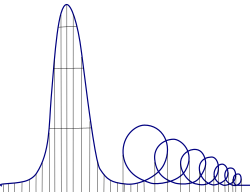Euthanasia Coaster
 From Wikipedia - Reading time: 5 min
From Wikipedia - Reading time: 5 min
| Euthanasia Coaster | |
|---|---|
 Track profile of the Euthanasia Coaster, showing its 500 m (1,600 ft) lift hill and seven clothoid inversions | |
| General statistics | |
| Type | Steel |
| Designer | Julijonas Urbonas |
| Model | Exa coaster |
| Lift/launch system | Cable lift hill |
| Height | 500 m (1,600 ft) |
| Length | 7,544 m (24,751 ft) |
| Speed | 360 km/h (220 mph) |
| Inversions | 7 |
| Duration | 3:20 |
| G-force | 10 |
The Euthanasia Coaster is a hypothetical steel roller coaster and euthanasia device designed with the sole purpose of killing its passengers.[1] The concept was conceived in 2010 and made into a scale model by Lithuanian artist Julijonas Urbonas, a PhD candidate at the Royal College of Art in London.
Urbonas, who had formerly been an amusement park employee, stated that the goal of his concept roller coaster is to take lives "with elegance and euphoria",[2] either for euthanasia or execution purposes.[3] John Allen, who had been the president of the Philadelphia Toboggan Company, inspired Urbonas with his description of the "ultimate" roller coaster as one that "sends out 24 people and they all come back dead".[4]
Design
[edit]The concept design of the layout begins with a steep-angled lift that takes riders up 500 metres (1,600 ft) to the top[1] (for comparison, the tallest roller coaster ever built, Kingda Ka, had a top hat that was 139 metres [456 ft] in height), a climb that would take a few minutes to complete, allowing the passengers to contemplate their life.[5][3] From there, all passengers are given the choice to exit the train, if they wish to do so. If they do not, they would have some time to say their last words.
All passengers are required to press a button to continue the ride, which then takes the train down a 500 m (1,600 ft) drop, propelling the train at speeds up to 360 kilometres per hour (220 mph; 100 m/s), close to its terminal velocity, before flattening out and speeding into the first of its seven slightly clothoid inversions.[3] Each inversion would decrease in diameter to maintain the lethal 10 g onto passengers as the train loses speed. After a sharp right-hand turn, the train would enter a straight track that goes back to the station, where the dead are unloaded and new passengers can board.[3]
Mechanism of action
[edit]
The Euthanasia Coaster would kill its passengers through prolonged cerebral hypoxia, or insufficient supply of oxygen to the brain.[1] The ride's seven inversions would inflict 10 g (g-force) on its passengers for 60 seconds, causing g-force related symptoms starting with greyout through tunnel vision to black out, and eventually g-LOC (g-force induced loss of consciousness) and death.[3] Subsequent inversions or a second run of the rollercoaster would serve as insurance against unintentional survival of more robust passengers.[3]
Exhibition
[edit]The Euthanasia Coaster was first shown as part of the HUMAN+ display at the Science Gallery in Dublin in 2012.[1] The display was later named the year's flagship exhibition by the Science Gallery.[6][7] Within this theme, the coaster highlights the issues that come with life extension.[8] The item was also displayed at the HUMAN+ exhibit at Centre de Cultura Contemporània de Barcelona in 2015.[9]
In pop culture
[edit]In 2012, Norwegian rock group Major Parkinson released "Euthanasia Roller Coaster", a digital single with lyrics alluding to Urbonas's Euthanasia Coaster.[10]
Sequoia Nagamatsu's novel How High We Go in the Dark, published on January 18, 2022, prominently features a euthanasia roller coaster for children afflicted with an incurable plague.[11]
References
[edit]- ^ a b c d Solon, Olivia (6 April 2011). "The Future of the Human Species Explored". WIRED Science. Condé Nast Publications. Retrieved 24 April 2011.
- ^ Lamar, Cyriaqe (18 April 2011). "The Euthanasia Coaster, the Last Roller Coaster You'll Ever Ride". Gawker Media. Archived from the original on 23 June 2018. Retrieved 24 April 2011.
- ^ a b c d e f "Euthanasia Coaster". 2 October 2010. Retrieved 30 September 2022.
- ^ "A Rollercoaster Designed to Kill Humanely". DesignTaxi. Halls Create Arts Pte Ltd. 20 April 2011. Archived from the original on 9 September 2016. Retrieved 23 April 2011.
- ^ Urbonas, Julijonas (2010). "Julijonas Urbonas". julijonasurbonas.lt.
- ^ "HUMAN+ The Future of Our Species". Trinity College Dublin. 1 February 2011. Archived from the original on 16 December 2019. Retrieved 24 April 2011.
- ^ Sheridan, Cormac (15 April 2011). "HUMAN+ Forecasting Our Future". NewScientist Culturelab. Reed Business Information Ltd. Archived from the original on 18 April 2011. Retrieved 24 April 2011.
- ^ Gorman, Michael John (22 April 2011). "HUMAN+ explores the technologically enhanced future of our species". Notes and Theories: Dispatches from the Science Desk. Guardian News and Media Ltd. Archived from the original on 11 January 2021. Retrieved 24 April 2011.
- ^ "Human+". CCCB. Archived from the original on 24 November 2015. Retrieved 13 December 2015.
- ^ "Major Parkinson er tilbake" Archived 11 January 2021 at the Wayback Machine Bergensavisen. Bergensavisen AS 23 July 2013. Retrieved 6 August 2013
- ^ “Strap in for highs and lows with the pandemic novel 'How High We Go in the Dark'“. Retrieved 26 August 2024.
 KSF
KSF